I think one of the best ways to improve your Japanese is to increase your exposure to media designed for native speakers. Many Japanese learners have books or manga they aspire to read, but it's important to first build up a strong foundation. One of the most popular recommendations for those who are new to reading Japanese native material is the slice-of-life series Yotsuba&!.
I love Yotsuba&! — actually, it was the first manga I read as a Japanese learner after advancing beyond graded readers. It's sweet and heartwarming, laugh-out-loud funny, and can put your Japanese skills to the test with a mix of different tones of voice and speaking styles. That said, there are a few things about Yotsuba&! that might be slight sticking points for Japanese learners, especially beginners.
Despite some less-than-beginner-friendly dialogue from a few of the characters, Yotsuba&!'s real-world setting, engaging story, cute illustrations, and bite-sized chapters make it a great stepping stone for any Japanese learner hoping to establish a Japanese language reading habit. In this article, I'll discuss some of Yotsuba&! pros and cons, so you can decide if it's the right series for you!
- What is Yotsuba&!?
- What Makes Yotsuba&! So Easy to Read?
- It's Not All Smooth Sailing…
- What Makes Yotsuba&! Such a Great First Book for Japanese Learners?
What is Yotsuba&!?
Yotsuba&! is a slice-of-life comedy manga about a five-year-old girl named Yotsuba and her father, Yousuke Koiwai. Yotsuba's name means "four leaves," and her green hair reflects this, as it's pulled into four ponytails like a four-leafed clover. The series starts with Yotsuba and her father relocating to a new neighborhood, where they get help from Yousuke's tall friend who's called Jumbo. Soon after they meet their new neighbors, the Ayase family: daughters, Ena, Fuuka, and Asagi (from youngest to oldest), their mother, and never-home father. Beyond this cast of characters, there are a few others who come and go: primarily friends of friends and relatives.
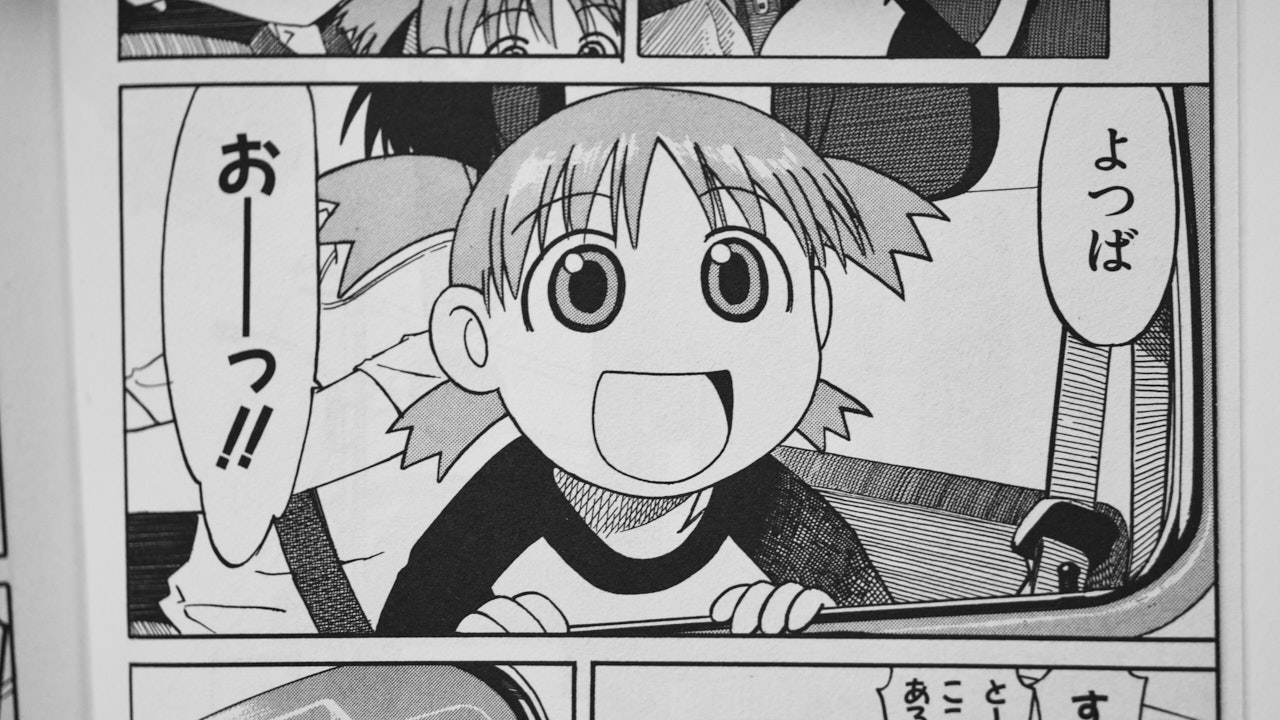
If you're not familiar with the genre, slice-of-life usually revolves around the daily occurrences in the characters' lives. There's no grand quest here, just regular activities that any reader can relate to, like running errands or special events like festivals. That said, the series is far from boring — Yotsuba always manages to make some mischief for herself. The world as seen through Yotsuba's eyes is a shining and exciting place. Most of the enjoyment and humor comes from her unique perspective, and seeing the other characters responding to her joy.
What Makes Yotsuba&! So Easy to Read?
Another major strength of Yotsuba&! in my view is the sheer readability of the series. There's a very low barrier to entry for those that want to read it, and being a manga composed of small vignettes, it's very digestible.
Bite-Sized, Self-Contained Stories
As the name Yotsuba&! implies, each chapter deals with Yotsuba and her experiences interacting with something new to her. For example, in the first volume, the chapters are よつばとひっこし (Yotsuba & Moving), よつばとあいさつ (Yotsuba & Greetings), よつばと 地球温暖化 (Yotsuba & Global Warming), よつばとかいもの (Yotsuba & Shopping), よつばとせみとり (Yotsuba & Catching Cicadas), and finally よつばとおおあめ (Yotsuba & A Downpour). While chapters are occasionally connected (Volume 3 has two chapters taking place at a Summer Festival, for example), for the most part each chapter acts as a self-contained story. This makes it easy to read just a chapter at a time, or to jump around, or skip a chapter that's too difficult for you. In fact, beyond the character introductions at the start of the series, you could probably just pick up any volume with little trouble.
It's easy to read just a chapter at a time, jump around, or skip a chapter that's too difficult.
Most of the chapters are also very short. While the series does establish a narrative over time, introducing new characters, and occasionally calling back to earlier scenes, most chapters function as small independent stories in Yotsuba's life. It's very easy to read one or two chapters a day, continually making progress, while not having to worry about forgetting something that happened previously.
ChristopherFritz from the WaniKani Community Forums agreed with me on this, saying "If I were giving someone advice for Yotsuba&! specifically, it would be to feel free to skip the more difficult chapters. It's so slice-of-life that you can just look at the pictures of a difficult chapter (such as those chapters with adults conversing with one another), then pick up reading on the next (often easier) chapter. One can always go back and re-read the series once they're at a higher level."
Daily-Life Vocabulary
While it's a comedy manga, and as such features a lot of eccentric dialogue and scenarios, you'll quickly notice it takes place in a very ordinary setting. Many beginner Japanese learners start out with fantastical stories, but Yotsuba&! is different: there's no magic or monsters, no swords or spaceships; just the offbeat adventures of a young girl and the people she knows. This is one of the big benefits of reading Yotsuba&! as a Japanese learner: there's no vocabulary specific to the setting you need to learn. Instead, all the words you come across relate to normal, everyday situations, albeit seen through a goofy, at-times slangy lens.
This way, you know the new words you come across will have broader applications than specific terms limited to science fiction or fantasy. And because Yotsuba&! covers such a wide range of topics, you're sure to pick up some new vocabulary. It's also a great way to learn about Japanese culture through both daily life and seasonal events specific to Japan. You'll get to know unique concepts and vocabulary related to Japanese culture, such as てるてる坊主 teru teru bōzu (dolls made with tissue paper to pray for good weather), or フンドシ fundoshi (traditional loincloths that men wear for festivals, etc.) and many more.
Art and Visual Cues
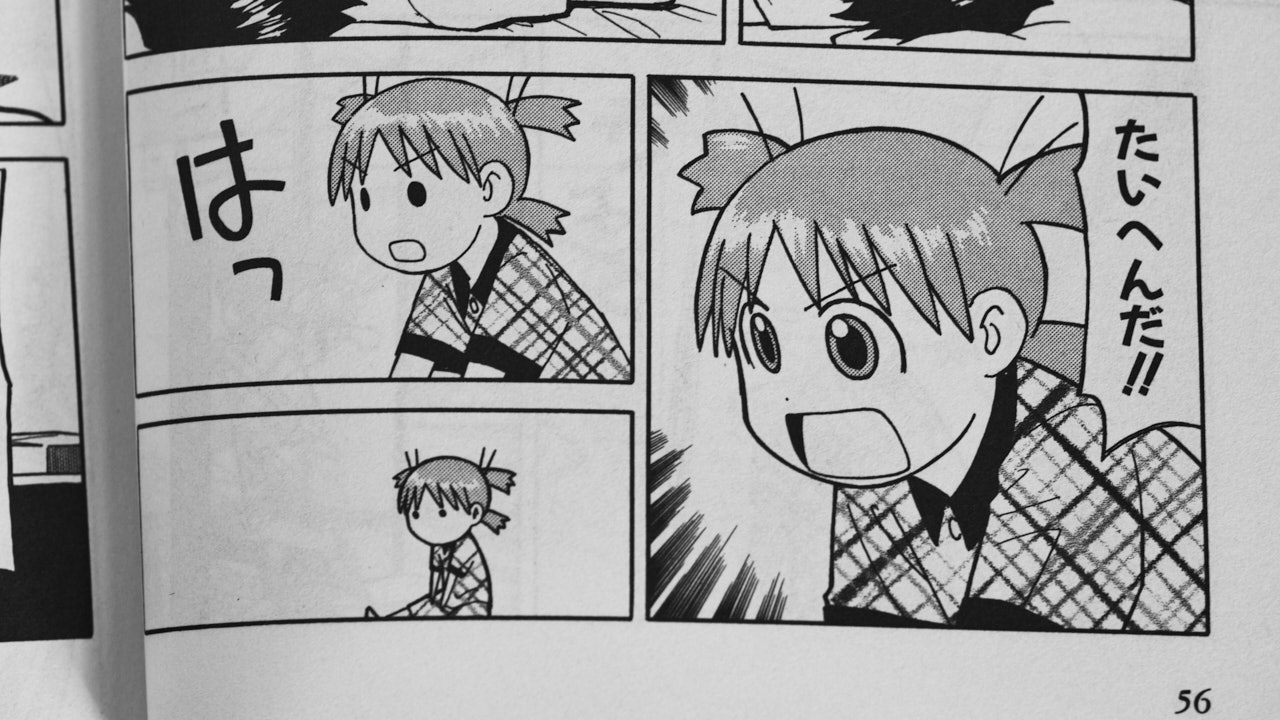
As Yotsuba&! is a manga series, the images are just as important as the words on the page. Yotsuba&!'s artwork is very cute, featuring simplified character designs reminiscent of some 4-koma1 series, especially in the case of Yotsuba herself. The art alternates between more realistic, and more stylized and expressive faces at key moments, particularly for Yotsuba herself. Unlike prose fiction, there's no exposition, and all the text is dialogue. The detailed artwork is a big plus for beginner Japanese learners, as it helps provide context to the story, making it easier to keep reading without looking things up every time you get stuck and even follow the basic storyline even without the dialogue. In fact, there are many panels without text that rely solely on the artwork to convey what happens next.
And… It's Just So Enjoyable!
In almost every chapter there was something I found to be truly laugh-out-loud funny.
Finally, Yotsuba&! is just very enjoyable in my opinion. Similar to many other stories in the genre, the story isn't too fast-paced, instead focusing on the joys of everyday life. I quickly grew to love the characters, who are all endearing and quirky in their own ways, and I looked forward to seeing how Yotsuba would respond to new situations. Yotsuba is very dramatic, and oftentimes doesn't quite get what's going on in the same way that an adult does. But additionally, she is amazed by a lot of things adults write off, and her joy is infectious to both the characters and the reader. Slice-of-life may not be everybody's cup of tea, but I feel Yotsuba&!'s pacing is noticeably faster than something like Shirokuma Café, and it always manages to surprise.
The humor is also not to be understated. In almost every chapter there was something I found to be truly laugh-out-loud funny. Even better, the humor is really varied: from complex wordplay and situations that set-up before a pay-off, to simple visual gags and one-off jokes. With Yotsuba&!'s short, self-contained chapters, elementary vocabulary and grammar, and expressive pictures, I think it's a great series to begin building a habit of reading something in Japanese every day. Even if you don't read a chapter in a sitting, just getting through a few pages every day will work wonders for your Japanese ability!
It's Not All Smooth Sailing…
That's not to say it's all smooth sailing, however. Especially if you're a beginner who has yet to venture beyond the textbooks, there are a few things about Yotsuba&! that might trip you up.
Different Speech Styles
In Yotsuba&!, a lot of the comedy comes from Yotsuba's charming behavior and style of speech that is wholly uncharacteristic of a five-year-old girl. If you've ever been caught off-guard by how unexpectedly mature or unintentionally rude kids can sometimes sound, you can probably guess why Yotsuba is so hilarious. She often uses very casual forms of speech that can border on impolite, which seem to come from her imitating how her father talks to her and his friends. For example, in the very beginning of the series, Yousuke tells her they're almost at their new home, to which Yotsuba replies すげぇ, a slangy form of すごい to mean "wow." She then comments on the number of houses there are, and he points out the number of shops as well, and Yotsuba replies, 「お店もか!?」, meaning, "There are shops, too?" — but putting か after the end of a question in informal language can sound very coarse or overly masculine for a small child.
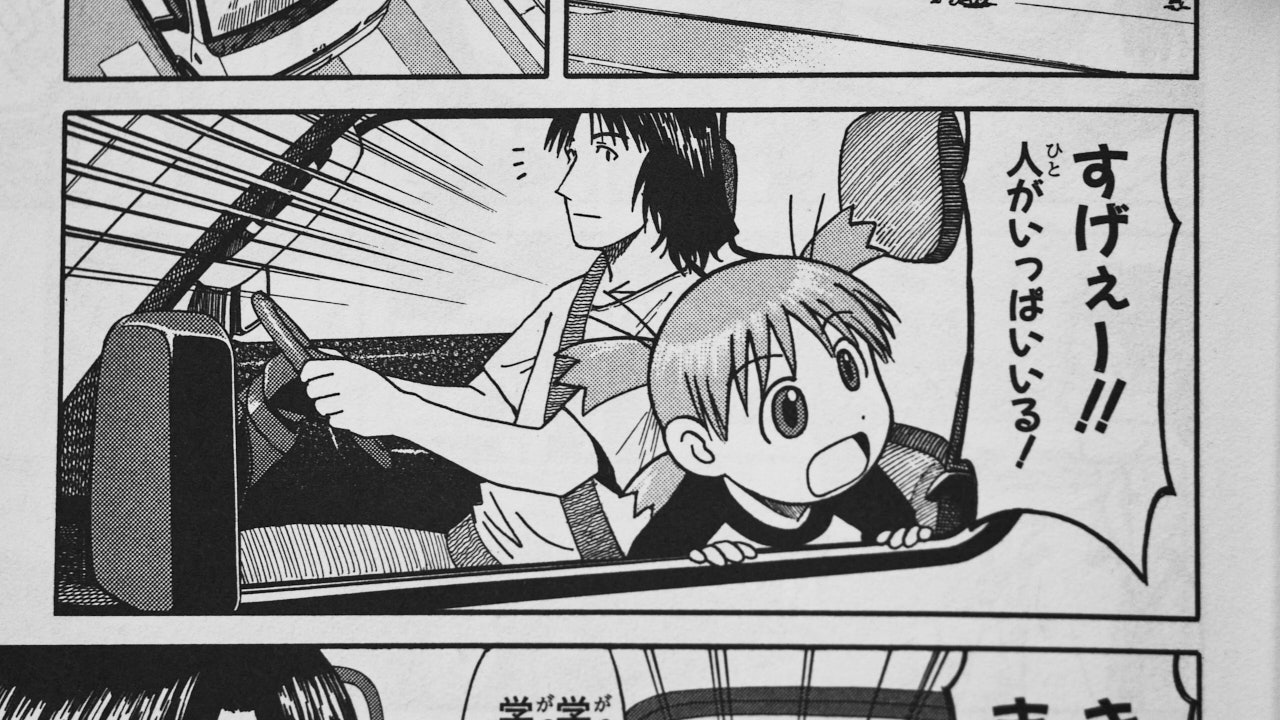
Additionally, Yotsuba's dialogue is largely written using kana alone, which can make deciphering the words she's using a bit harder still. Combining this with her style of speech, there were times where I would get confused about something she was saying, even if I later realized I actually did know the word she was using in a particular scene.
Yotsuba generally speaks like her father, specifically the casual speech he uses with people close to him.
Really, Yotsuba's way of speaking is funny, but may not be one to imitate or use for serious study, especially when you're talking to people you don't have a close relationship with. She seems to imitate her father who speaks very casually, especially with his friends Jumbo and Yanda, who is introduced a little later into the series. For example, Yousuke sometimes refers to his friends as あいつ, which is both masculine and can come across as rude depending on the relationship between you and the person you're talking to. So, just keep in mind — Yotsuba generally speaks like her father, specifically the casual speech he uses with people close to him. Although adults are often more adept at manipulating their way of speaking depending on the situation or whom they are talking to, as a child, Yotsuba's still learning, and she often uses the casual (and masculine) speech style no matter whom she's talking to.
On the other hand, Yotsuba and her fathers's next door neighbors, the Ayase family, are generally very polite. Dialogue from the Ayase's — particularly from Ena, the youngest sister, and Fuuka, the middle child — will be very familiar to those who have studied Japanese from a textbook before. For example, here's how Fuuka introduces herself to Yousuke when she sees them moving in: 「私となりに住んでおります。綾瀬と申します。よろしくお願いいたします。」which can be roughly translated to "My name is Ayase. I live next door. Pleased to meet you." As you can see, she's using kenjōgo, or humble speech here, though she loosens up a bit as she becomes more familiar with the Koiwai family. Contrast that with how Yousuke responds, however: 「ああいえ、こちらこそよろしく。」 meaning, "Oh yeah, you too."
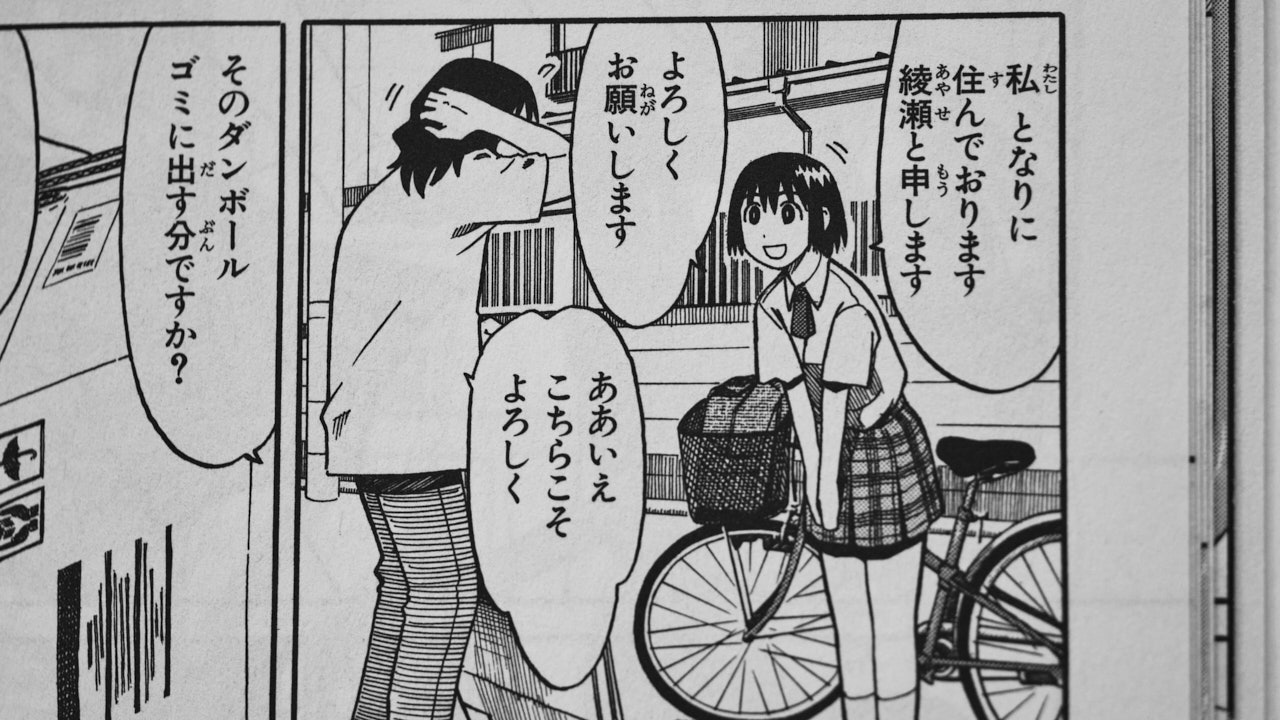
While Yotsuba's, Yousuke's, and his friends' casual (and slangy) speech style might throw off beginners who learned Japanese primarily from textbooks up to this point, try to remember that the language used in Yotsuba&! is a lot more colloquial and closer to how some people actually talk in daily life. Reading Yotsuba&! is great practice to get used to these different styles of speaking.
Study Limitations
In my opinion, reading Yotsuba&! is more about growing confidence and learning you can read and enjoy native Japanese material.
The second issue with Yotsuba&! is also a pro and a con: it's rather light! Like I mentioned before, as a manga, all the text is dialogue, so a learner won't get a chance to read exposition like they would in a novel or short story. Being constrained to spoken text is fairly significant, especially as the dialogue tends to be sparse. There's just not a lot of text there. This makes it both easier to get into, but harder to push yourself with. And again, while the artwork's added context makes it a lot easier to increase your comprehension of a scene, it's perhaps less effective for studying since the hints it gives the reader can negate the need to read around unknown words to understand them from the sentence's context alone..
As a result of all this, I think Yotsuba&! is best suited for learning how to read in Japanese and building the habit, rather than finding super in-depth study material. In fact, there are very few sentences I would recommend copying from the book for further study, so if your primary goal is something like sentence mining, your best bet is to look elsewhere. In my opinion, reading Yotsuba&! is more about growing confidence and learning you can read and enjoy native Japanese material.
What Makes Yotsuba&! Such a Great First Book for Japanese Learners?
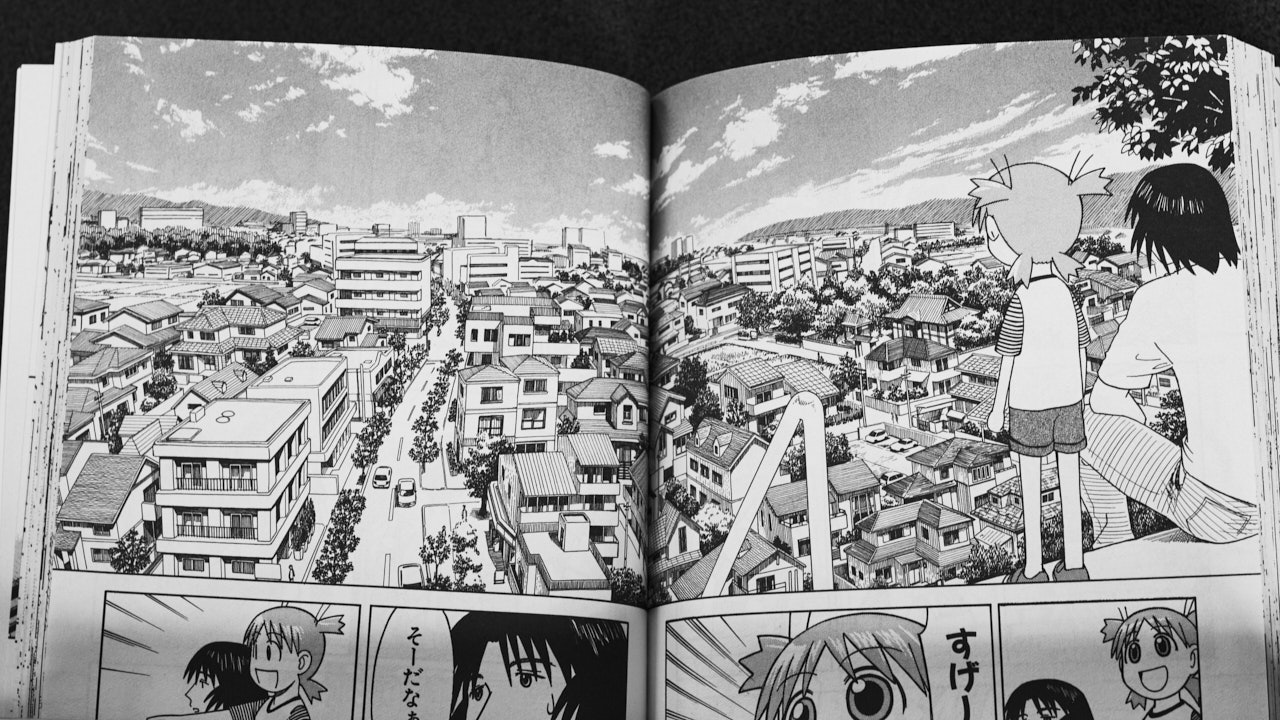
If you are looking for more Japanese reading practice — or just to get used to reading in Japanese, finding the joy in it, and building a habit of doing so — Yotsuba&! might be the series you are looking for. At its core, Yotsuba&! is a great beginner series, suitable for many learners who've worked through a beginner textbook like Genki. The art and overall compactness of the dialogue help tremendously with understanding new vocabulary or grammar points through context, and as Yotsuba&! is structured as short, independent chapters, it's easy to skip one if you're having difficulty.
Hopefully, my review has helped you figure out if Yotsuba&! seems suited to your level and interests!
When working through a new native source, I've found that it takes pushing through about the first 20% or so before I begin to feel comfortable reading.
Generally, I've found that when working through a new native source, be it a manga series like Yotsuba&!, a book like 時をかける少女 (The Girl Who Leapt Through Time), or a resource like NHK Easy News, I find it takes pushing through about the first 20% or so before I begin to feel comfortable reading. Especially for learners who haven't yet tried to read anything in Japanese, it wouldn't be uncommon to look through the first chapter of Yotsuba&! and feel it's too difficult. However, I highly recommend just sticking with it, and trying your best to get through the first few chapters if you're struggling. Afterwards, as you adjust to the style, I think more likely than not you'll either find that it becomes much easier to read, or that it's just not the right resource for you right now.
If you want to interact and ask questions with other Japanese learners, about Yotsuba&! other manga series, books, light novels, or whatever strikes your fancy, I highly recommend checking out the WaniKani Community Forum Book Club thread. There you can find discussions for every single volume of Yotsuba&!, as well as many other books at the beginner, absolute beginner, and intermediate levels. I've always found this to be not only very helpful for checking comprehension, but also encouraging to see other learners at my level, and read discussions about different books.
Ian’s Review
Like I said at the start, I love Yotsuba&!. I’ve always been a fan of these sorts of slice-of-life stories, and I think it’s a charming, heartwarming entry in the genre. It somehow manages to be equal parts sincere and hilarious. It can be difficult to get over the initial barrier with Yotsuba&! as a beginner, given the number of shifts in tone and formality throughout the first volume, but after you become more accustomed to the style, it gets easier. Even so, Yotsuba&! doesn’t contain many sentences I would directly study from, but I still think it’s a great series to get started reading Japanese, and to build a habit to take your Japanese to the next level. The setting and tone won’t be everyone’s cup of tea, but if it is, I think you’ll be delighted with what you find.
Kanae’s Review
I’m a big fan of Yotsuba&!. I love it, both as a native speaker of Japanese, as well as someone who supports learners of Japanese. From both perspectives, I found it to be an incredibly high-quality work in terms of art, story, and how realistically things are described. Yotsuba& is undeniably one of the more popular series among Japanese learners and I think that’s because they genuinely enjoy reading it, which is very important for you to keep going. Although it wasn’t necessarily intended for language learners, I think it turned out to be accessible and enjoyable for those who study Japanese as a foreign language.
…Do you want to hear even more about "Yotusba&!"? If you couldn't get enough of it, or are not convinced (yet), here's a podcast episode you can listen to learn more about Yotsuba&!
-
4-coma refers to 4コマ 漫画, or "four cell manga," which are generally gag or comic strips consisting of four identically sized panels stacked vertically on top of one another. ↩
